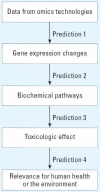Meeting report: Validation of toxicogenomics-based test systems: ECVAM-ICCVAM/NICEATM considerations for regulatory use
- PMID: 16507466
- PMCID: PMC1392237
- DOI: 10.1289/ehp.8247
Meeting report: Validation of toxicogenomics-based test systems: ECVAM-ICCVAM/NICEATM considerations for regulatory use
Abstract
This is the report of the first workshop "Validation of Toxicogenomics-Based Test Systems" held 11-12 December 2003 in Ispra, Italy. The workshop was hosted by the European Centre for the Validation of Alternative Methods (ECVAM) and organized jointly by ECVAM, the U.S. Interagency Coordinating Committee on the Validation of Alternative Methods (ICCVAM), and the National Toxicology Program (NTP) Interagency Center for the Evaluation of Alternative Toxicological Methods (NICEATM). The primary aim of the workshop was for participants to discuss and define principles applicable to the validation of toxicogenomics platforms as well as validation of specific toxicologic test methods that incorporate toxicogenomics technologies. The workshop was viewed as an opportunity for initiating a dialogue between technologic experts, regulators, and the principal validation bodies and for identifying those factors to which the validation process would be applicable. It was felt that to do so now, as the technology is evolving and associated challenges are identified, would be a basis for the future validation of the technology when it reaches the appropriate stage. Because of the complexity of the issue, different aspects of the validation of toxicogenomics-based test methods were covered. The three focus areas include a) biologic validation of toxicogenomics-based test methods for regulatory decision making, b) technical and bioinformatics aspects related to validation, and c) validation issues as they relate to regulatory acceptance and use of toxicogenomics-based test methods. In this report we summarize the discussions and describe in detail the recommendations for future direction and priorities.
Figures


Similar articles
-
The Interagency Coordinating Committee on the Validation of Alternative Methods (ICCVAM): a review of the ICCVAM test method evaluation process and current international collaborations with the European Centre for the Validation of Alternative Methods (ECVAM).Altern Lab Anim. 2002 Dec;30 Suppl 2:23-32. doi: 10.1177/026119290203002S04. Altern Lab Anim. 2002. PMID: 12513648 Review.
-
Implementation of the 3Rs (refinement, reduction, and replacement): validation and regulatory acceptance considerations for alternative toxicological test methods.ILAR J. 2002;43 Suppl:S85-94. doi: 10.1093/ilar.43.suppl_1.s85. ILAR J. 2002. PMID: 12388858 Review.
-
A new path forward: the Interagency Coordinating Committee on the Validation of Alternative Methods (ICCVAM) and National Toxicology Program's Interagency Center for the Evaluation of Alternative Toxicological Methods (NICEATM).J Am Assoc Lab Anim Sci. 2015 Mar;54(2):170-3. J Am Assoc Lab Anim Sci. 2015. PMID: 25836963 Free PMC article.
-
Report of the EPAA-ECVAM workshop on the validation of Integrated Testing Strategies (ITS).Altern Lab Anim. 2012 Jul;40(3):175-81. doi: 10.1177/026119291204000310. Altern Lab Anim. 2012. PMID: 22943518
-
The 3T3 neutral red uptake phototoxicity test: practical experience and implications for phototoxicity testing--the report of an ECVAM-EFPIA workshop.Regul Toxicol Pharmacol. 2012 Aug;63(3):480-8. doi: 10.1016/j.yrtph.2012.06.001. Epub 2012 Jun 9. Regul Toxicol Pharmacol. 2012. PMID: 22687423
Cited by
-
The principles of weight of evidence validation of test methods and testing strategies. The report and recommendations of ECVAM workshop 58.Altern Lab Anim. 2006 Dec;34(6):603-20. doi: 10.1177/026119290603400604. Altern Lab Anim. 2006. PMID: 17266393 Free PMC article. No abstract available.
-
Transcriptomics in Toxicogenomics, Part I: Experimental Design, Technologies, Publicly Available Data, and Regulatory Aspects.Nanomaterials (Basel). 2020 Apr 15;10(4):750. doi: 10.3390/nano10040750. Nanomaterials (Basel). 2020. PMID: 32326418 Free PMC article. Review.
-
Improved Algal Toxicity Test System for Robust Omics-Driven Mode-of-Action Discovery in Chlamydomonas reinhardtii.Metabolites. 2019 May 10;9(5):94. doi: 10.3390/metabo9050094. Metabolites. 2019. PMID: 31083411 Free PMC article.
-
Toxicogenomics in regulatory ecotoxicology.Environ Sci Technol. 2006 Jul 1;40(13):4055-65. doi: 10.1021/es0630184. Environ Sci Technol. 2006. PMID: 16856717 Free PMC article. No abstract available.
-
A toxicology for the 21st century--mapping the road ahead.Toxicol Sci. 2009 May;109(1):18-23. doi: 10.1093/toxsci/kfp059. Epub 2009 Apr 8. Toxicol Sci. 2009. PMID: 19357069 Free PMC article.
References
-
- Ball CA, Sherlock G, Parkinson H, Rocca-Sera P, Brooksbank C, Causton HC, et al. Standards for microarray data. Science. 2002;298:539. - PubMed
-
- Balls M, Blaauboer BJ, Fentem JH, Bruner L, Combes RD, Ekwall B, et al. Practical aspects of validation of toxicity test procedures. Altern Lab Anim. 1995;23:129–147.
-
- Bammler T, Beyer RP, Bhattacharya S, Boorman GA, Boyles A, Bradford BU, et al. Standardizing global gene expression analysis between laboratories and across platforms. Nat Methods. 2005;2:351–356. - PubMed
-
- Blower PE, Yang C, Fligner MA, Verducci JS, Yu L, Richman S, et al. Pharmacogenomic analysis: correlating molecular substructure classes with microarray gene expression data. Pharmacogenomics J. 2002;2(4):259–271. - PubMed
Publication types
MeSH terms
LinkOut - more resources
Full Text Sources

